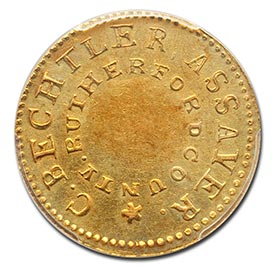
Bechtler North Carolina & Georgia Gold (1831-1852)
Territorial and private issues were common all the way through the Coinage Acts of 1857 and 1864, which banned private and foreign money from circulating alongside U.S.-minted currency. There were still private issues that circulated in Western states and territories like Utah and California even after this act. Some of these were certified by the U.S. government before official mints were put in place, while others only saw circulation for a limited period of time. The Bechtler family created several different private issues for Gold, which circulated widely in the Southeast.
Bechtler Gold Design
The history of early United States coins embraces a wide variety of money, not just coins minted within the United States itself. World coins saw common usage across the whole of the United States, and major denominations from countries like the Netherlands, France, and Spain were widely circulated through the 1850s. British coins were commonplace, not surprising considering the American colonies were under British rule. The bulk of coinage was English crowns, shilling and pence as well as the Spanish piece of eight (which laid the groundwork for the Silver dollar). This began to change as the U.S. started striking its own coins, but this currency still circulated alongside it.
Foreign coins were not the only circulating currency in the New World. Private issues were also available, and there were circulating coins created by some of the states in both colonial and post-colonial times. There are several major privacy issues that were created in the Americas and saw varying degrees of circulation. After the colonial era, many of these were Gold coins created to fill in the gaps in higher-denomination coinage. Gold private and regional issues saw use even after they technically became illegal, particularly out in the Western states.
Christopher Bechtler moved to Rutherford County, North Carolina from his home in Germany. Bechtler was assisted by his son August and his nephew Christopher. This area of the country was a hotbed for Gold, as the Piedmont area of North Carolina and Georgia was the primary source of the Precious Metal.
The Bechtler family produced Gold for $1, $2.50 and $5 pieces. These pieces had a wide variety of weights and sizes, though. Many of these coins have rotated dies. Bechtler put the inscription “AUGUST 1, 1834” on several $5 varieties to avoid possible trouble with Treasury authorities.
Historical Significance
Bechtler’s Gold dollars were the first Gold dollars created in the United States. These pieces were regularly circulated through the Southeast, though when the Coinage Act of 1834 passed and Gold went up many of these were melted.
Numismatic Value
Bechtler Gold coins are uncommon and expensive in even lower grades. There are a few variants that go for over a hundred thousand dollars in high grades. Many were melted in 1834 as the price of Gold went up, and more were melted in the mass repossession of Gold by Franklin D. Roosevelt. The North Carolina National Bank of Charlotte has one of the largest collections of these coins still in existence.
Expand your collection today and shop our assortment of Territorial Gold Coins.

PCGS Products
You need the most up-to-date pricing on your coin collection. That’s why APMEX has partnered with PCGS, the premier grading authority in the world of rare coins, to bring you constantly updated pricing on collectibles and rarities. PCGS has been grading coins since 1986, bringing consistent standards of quality to a fractured industry. In the years since they have remained a source of reliable information on the current collectible and rare coin market.




